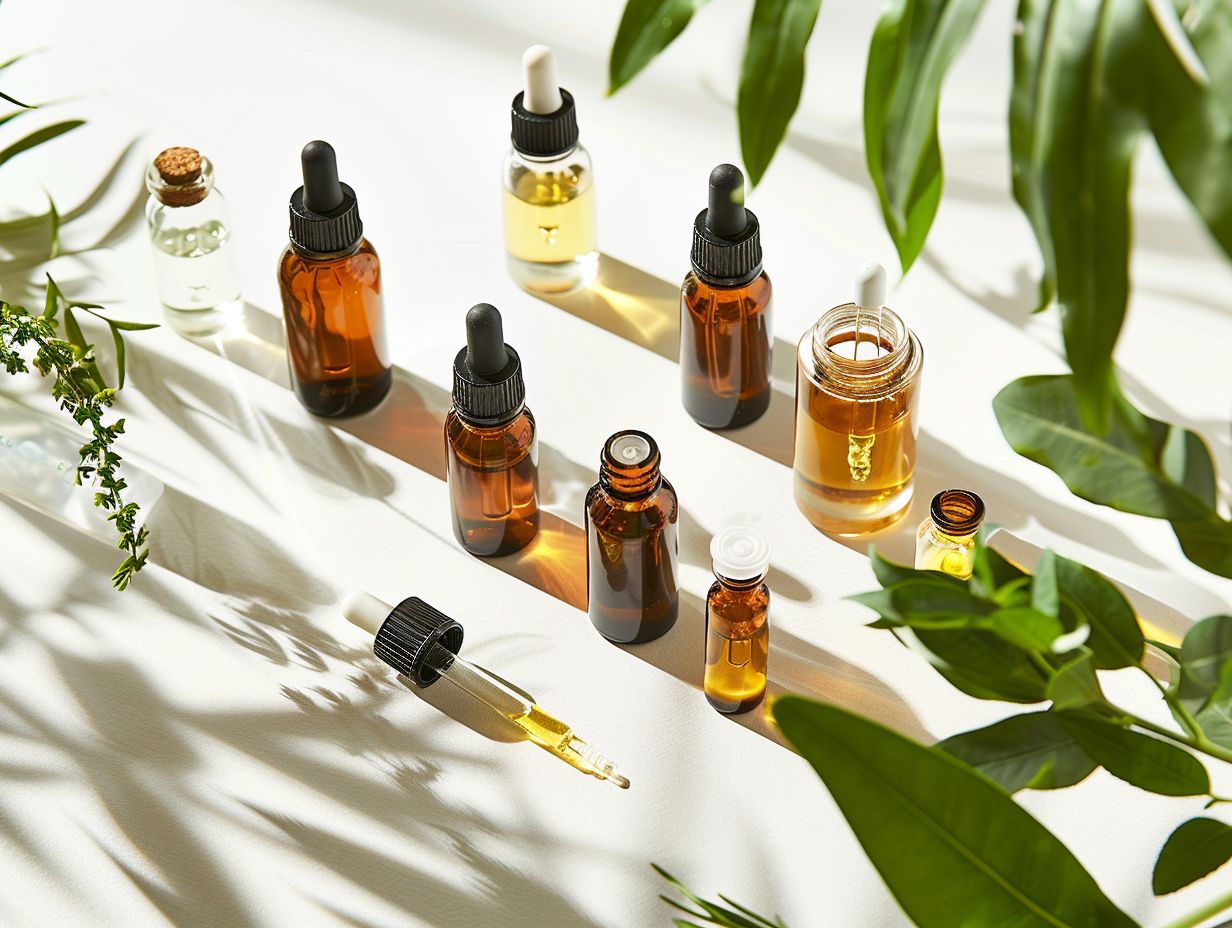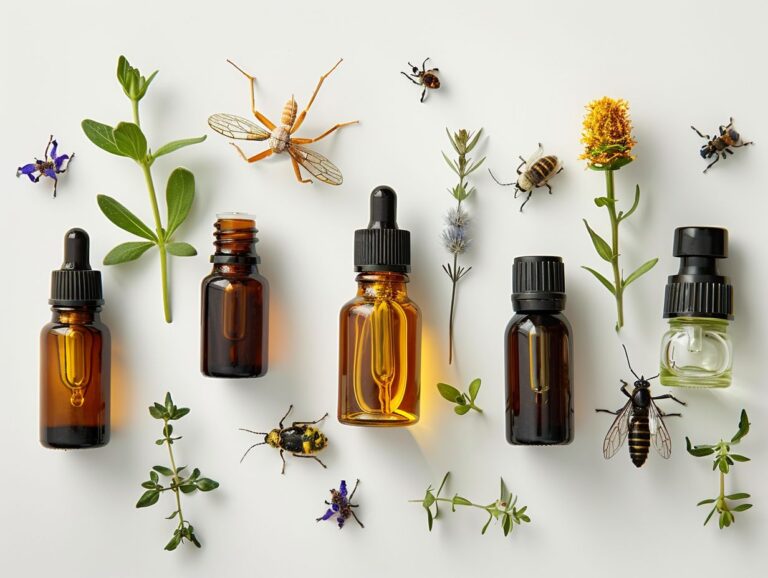How Many Essential Oils Can Be Mixed Together for Skin
Essential oils have become popular for their various benefits, especially when it comes to skin care.
We will explore the factors to consider when blending essential oils, the benefits of mixing them for skin, as well as the potential risks involved.
We will also provide tips on how to safely mix essential oils and highlight which combinations are safe or should be avoided.
Discover the secrets of creating a customized and effective skincare routine with essential oils.
Key Takeaways:
What Are Essential Oils?
Essential oils are concentrated extracts obtained from plants that capture the plant’s scent and flavor, also known for their therapeutic properties.
These oils have been used for centuries in various cultures for their medicinal and aromatic benefits. The origins of essential oils can be traced back to ancient civilizations like Egypt, where they were highly valued for their healing properties.
- Extraction methods vary depending on the plant source, with popular techniques including steam distillation, cold pressing, and solvent extraction.
- Each essential oil has unique properties and uses. For instance, Lavender oil is often used for its calming effects, while Peppermint oil is known for its energizing properties.
From promoting relaxation and enhancing mood to aiding digestion and supporting skin health, essential oils offer a natural and holistic approach to wellness.
How Many Essential Oils Can Be Mixed Together?
When blending essential oils, it is essential to consider the compatibility of various oils and the desired outcome of the blend.
What Factors Should Be Considered When Mixing Essential Oils?
Several factors should be taken into account when mixing essential oils, including the aroma notes, blend ratio, carrier oils used, and the intended purpose of the blend.
Choosing the right carrier oil is crucial to ensure that the essential oils are properly diluted and safely applied to the skin. Certain carrier oils have specific properties that can complement or enhance the effects of the essential oils. Understanding the aroma profiles of different essential oils is essential for creating harmonious blends.
Determining the optimal blend ratios is a delicate balance that can significantly impact the effectiveness and aroma of the final product. It’s also important to consider the intended purpose of the blend, whether it’s for relaxation, focus, or skincare.
What Are the Benefits of Mixing Essential Oils for Skin?
Mixing essential oils for skin offers a range of benefits, including customized skincare solutions, enhanced aromatherapy experiences, and increased effectiveness in addressing skin concerns.
Customized Skin Care
Customized skincare with essential oil blends allows individuals to tailor their skincare routine to address specific skin concerns or preferences.
Having a personalized skincare regimen is crucial as it enables you to cater to the unique needs of your skin. By incorporating essential oil blends, you can take this customization a step further by leveraging the capabilities of nature to provide targeted solutions. These blends are crafted by combining different essential oils known for their specific properties, such as hydrating, soothing, or rejuvenating.
One of the advantages of creating custom face blends is the ability to choose suitable carrier oils that complement your skin type. Different carrier oils offer various benefits, from regulating oil production to promoting a radiant complexion. Pairing these oils with essential oils creates a synergy that enhances the efficacy of your skincare routine.
This tailored approach ensures that you are using products that are specifically formulated to address your skin’s unique requirements, leading to improved overall skin health and appearance.
Enhanced Aromatherapy
Blending essential oils for skincare not only benefits the skin but also enhances the aromatherapy experience, promoting relaxation, stress relief, and overall well-being.
When combining essential oils to create aromatic blends for skincare, it s important to consider the therapeutic properties of each oil. For example, lavender oil is known for its calming effects, while citrus oils like bergamot and sweet orange can uplift the mood. By experimenting with different essential oil combinations, individuals can customize their skincare routine to cater to their specific needs.
Aromatherapy has been used for centuries to improve mental health and overall well-being. The inhalation of essential oil blends can directly impact the limbic system in the brain, which plays a crucial role in emotions and memories. This direct connection can help alleviate stress, anxiety, and even improve focus and concentration.
Increased Effectiveness
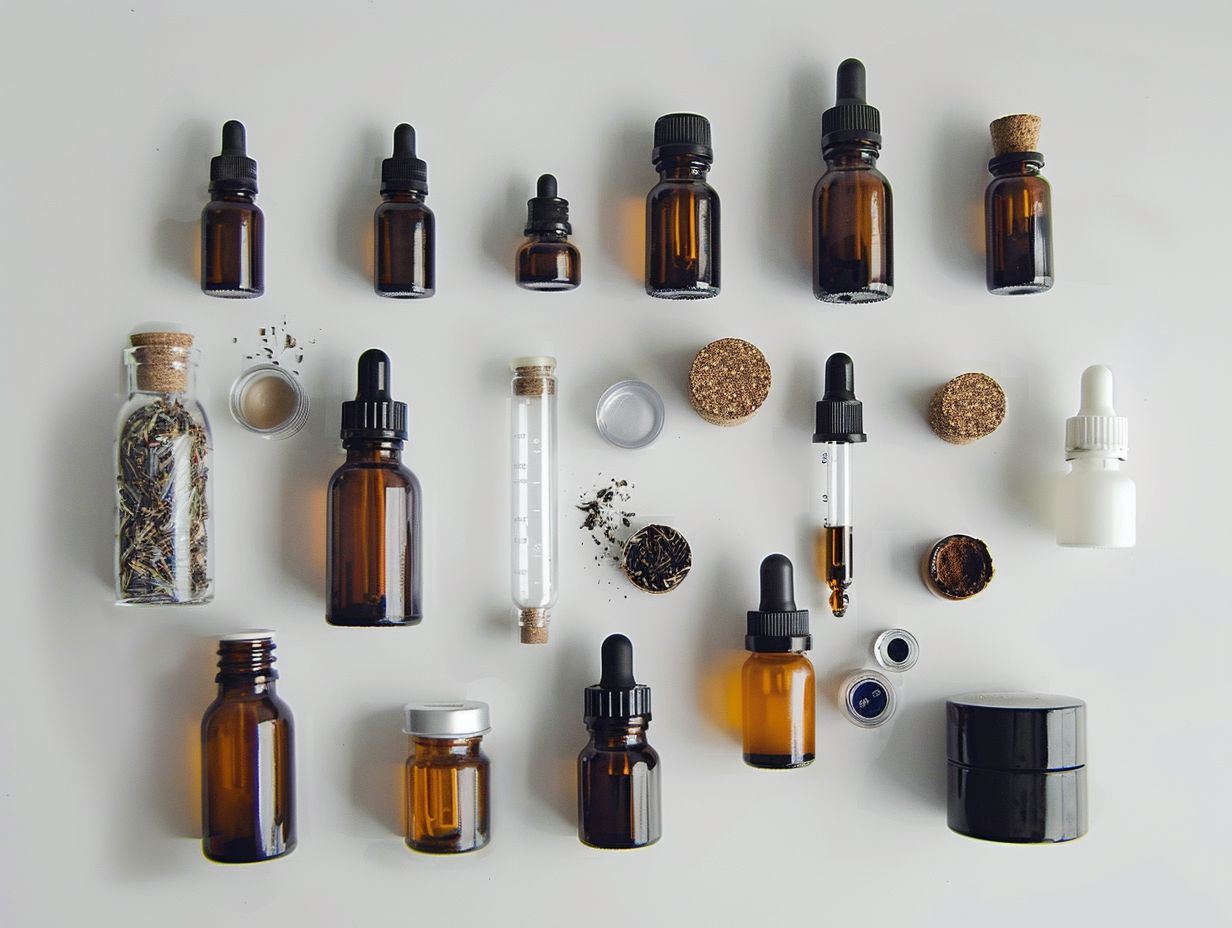
The synergy created by mixing essential oils for skin can enhance the overall effectiveness of the skincare routine, addressing multiple skin concerns simultaneously.
Blending essential oils not only adds a pleasing aroma to your skincare products but also provides a plethora of skin benefits. For example, combining lavender and chamomile oils can help soothe irritated skin and reduce redness, while a mixture of tea tree and eucalyptus oils can combat acne-causing bacteria and promote clearer skin.
The combined nourishing properties of oils like rosehip, argan, and jojoba can deeply moisturize the skin, improve elasticity, and reduce the appearance of fine lines and wrinkles, offering a holistic approach to skincare.
What Are the Risks of Mixing Essential Oils for Skin?
While mixing essential oils for skin can offer benefits, it is crucial to be aware of potential risks such as skin irritation, allergic reactions, and photosensitivity.
Skin Irritation
One of the risks associated with mixing essential oils for skin is the potential for skin irritation, especially when using concentrated oils or improper dilution.
It is crucial to dilute essential oils properly before applying them to the skin. A general rule of thumb is to use a carrier oil, such as jojoba or coconut oil, to dilute the essential oil, reducing the risk of irritation. Patch testing is essential to check for any adverse reactions before using the oil more extensively.
When selecting essential oils for the skin, opt for gentle options like lavender or chamomile, known for their skin-friendly properties. Avoid oils with high levels of potential irritants, like citrus oils, on sensitive skin areas.
Allergic Reactions
Individuals may experience allergic reactions when mixing essential oils for skin, underscoring the need for proper testing, patch testing, and dilution to prevent adverse skin responses.
For many, the allure of using blended essential oils in skincare routines is undeniable. It is essential to understand that even natural products can trigger allergic responses in some individuals.
Allergic reactions can manifest in various ways, from redness and irritation to more severe symptoms like swelling and blistering. Hence, it is crucial to conduct a patch test before applying any new blend to a larger area. Diluting potent oils with carrier oils can also significantly reduce the risk of triggering allergic skin reactions, ensuring a safer experience for skincare enthusiasts.
Photosensitivity
Certain essential oils can cause photosensitivity, making the skin more sensitive to sunlight and increasing the risk of sunburn when applied topically.
Photosensitivity is a reaction that occurs when certain compounds in essential oils react with UV light, leading to skin irritation and potential damage. Oils such as bergamot, lemon, lime, and grapefruit are known to be photosensitive due to their high content of compounds called furocoumarins. When using these oils topically, it is crucial to dilute them properly to minimize the risk of adverse reactions. It is advisable to avoid direct sunlight exposure for at least 12 hours after applying photosensitive oils to the skin to prevent skin damage and burns.
How to Safely Mix Essential Oils for Skin?
To ensure safe blending of essential oils for skin, it is essential to dilute oils properly, conduct patch tests, and adhere to recommended dosages for each blend.
Dilute Properly
Diluting essential oils with a suitable carrier oil is crucial to prevent skin irritation and ensure safe application on the skin.
Using the correct dilution ratios is vital to avoid adverse reactions such as redness, itching, or a burning sensation that can occur when essential oils are applied undiluted. The carrier oil acts as a base that helps to spread the essential oils across the skin, enhancing absorption and reducing the risk of sensitization.
Common carrier oil options include jojoba, coconut, almond, and grapeseed oil, each offering unique properties that complement different skin types and enhance the overall benefits of the essential oils being used.
Proper dilution not only ensures skin safety but also optimizes the therapeutic effects of the essential oils. By diluting them effectively, you can enjoy the aromatic and healing properties without overwhelming the skin or senses.
Patch Test
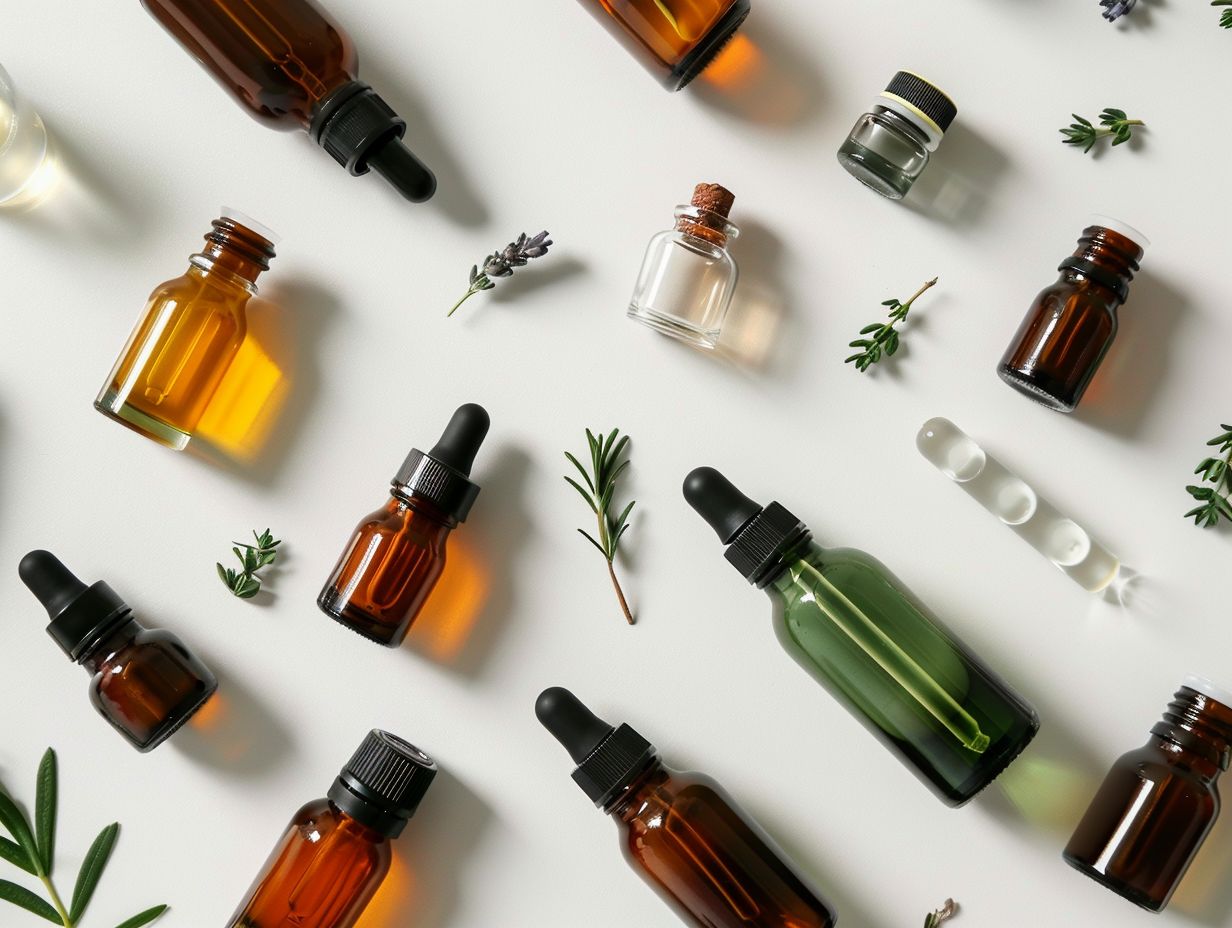
A patch test is a simple yet crucial step in ensuring the safe use of essential oils on the skin. To conduct a patch test accurately, follow these steps:
- Choose a small area of skin, like the inner forearm or behind the ear, that is clean and dry.
- Dilute the essential oil blend with a carrier oil to a safe concentration. A common ratio is 1-2 drops of essential oil per teaspoon of carrier oil.
- Apply a small amount of the diluted blend to the chosen skin area and cover it with a bandage or adhesive patch.
- Leave the patch undisturbed for 24-48 hours, avoiding contact with water.
- After the designated time, remove the patch and observe the skin for any redness, itching, swelling, or other signs of irritation.
- If no adverse reactions occur, the blend can likely be safely used on a larger skin area. If any irritation is present, wash the area with mild soap and water and refrain from using the oil blend.
Follow Recommended Dosages
Adhering to recommended dosages for each essential oil blend is essential to prevent adverse effects and ensure the safe use of aromatherapy products on the skin.
When creating your own essential oil blends, it is crucial to carefully follow the dosage guidelines provided by reputable sources. Essential oils are potent substances that can cause skin irritation, sensitization, or even adverse reactions if used in excess. Overusing essential oils can lead to sensitivities and is not recommended.
Dilution ratios play a vital role in maintaining both the effectiveness and safety of the blends. Ensuring proper dilution not only reduces the risk of skin irritation but also helps the oils penetrate the skin effectively for therapeutic benefits.
Which Essential Oils Are Safe to Mix for Skin?
Certain essential oils, such as Lavender and Tea Tree, Frankincense and Rose, and Peppermint and Eucalyptus, are safe to mix for skin due to their complementary properties and low risk of skin sensitivities.
Lavender and Tea Tree
The combination of Lavender and Tea Tree essential oils offers a harmonious blend for skin, providing soothing, cleansing, and balancing benefits without significant allergic risks.
Lavender oil is known for its calming properties, making it ideal for reducing skin redness and irritation. On the other hand, Tea Tree oil is a powerful antibacterial and antimicrobial agent, perfect for combating acne and other skin infections.
When combined, these oils create a potent mixture that can address a wide range of skin concerns, from dryness and itching to blemishes and inflammation.
The antibacterial nature of Tea Tree oil helps to cleanse the skin deeply, while Lavender’s soothing effects promote skin healing and regeneration.
Frankincense and Rose
Frankincense and Rose essential oils create a luxurious blend for skin, offering rejuvenating, anti-aging, and moisturizing effects that promote skin health and vitality.
Frankincense, known for its anti-inflammatory properties, can help reduce redness and irritation, making it ideal for sensitive or acne-prone skin. Combined with the hydrating and toning properties of Rose oil, this duo forms a potent skincare solution that aids in cell regeneration and collagen production, combating fine lines and wrinkles. Their antioxidant-rich nature protects the skin from environmental stressors, such as pollution and UV rays, contributing to a radiant complexion.
Peppermint and Eucalyptus
Peppermint and Eucalyptus essential oils offer a refreshing and invigorating blend for skin, known for their cooling, decongestant, and clarifying properties that benefit skin health and vitality.
When applied to the skin, the cooling sensation of Peppermint oil can help soothe irritation, reduce redness, and provide a revitalizing effect. Its antimicrobial properties make it beneficial for combating acne and promoting overall skin health.
Eucalyptus oil, on the other hand, is renowned for its clarifying and purifying abilities, making it a fantastic choice for oily or congested skin. The combination of these two oils not only uplifts and refreshes the skin but also helps in maintaining a balanced complexion.
Which Essential Oils Should Not Be Mixed for Skin?
Certain essential oils, such as Citrus Oils and Cinnamon, Clove and Wintergreen, and Birch, should not be mixed for skin applications due to potential skin sensitivities, phototoxic reactions, or irritations.
Citrus Oils and Sun Exposure
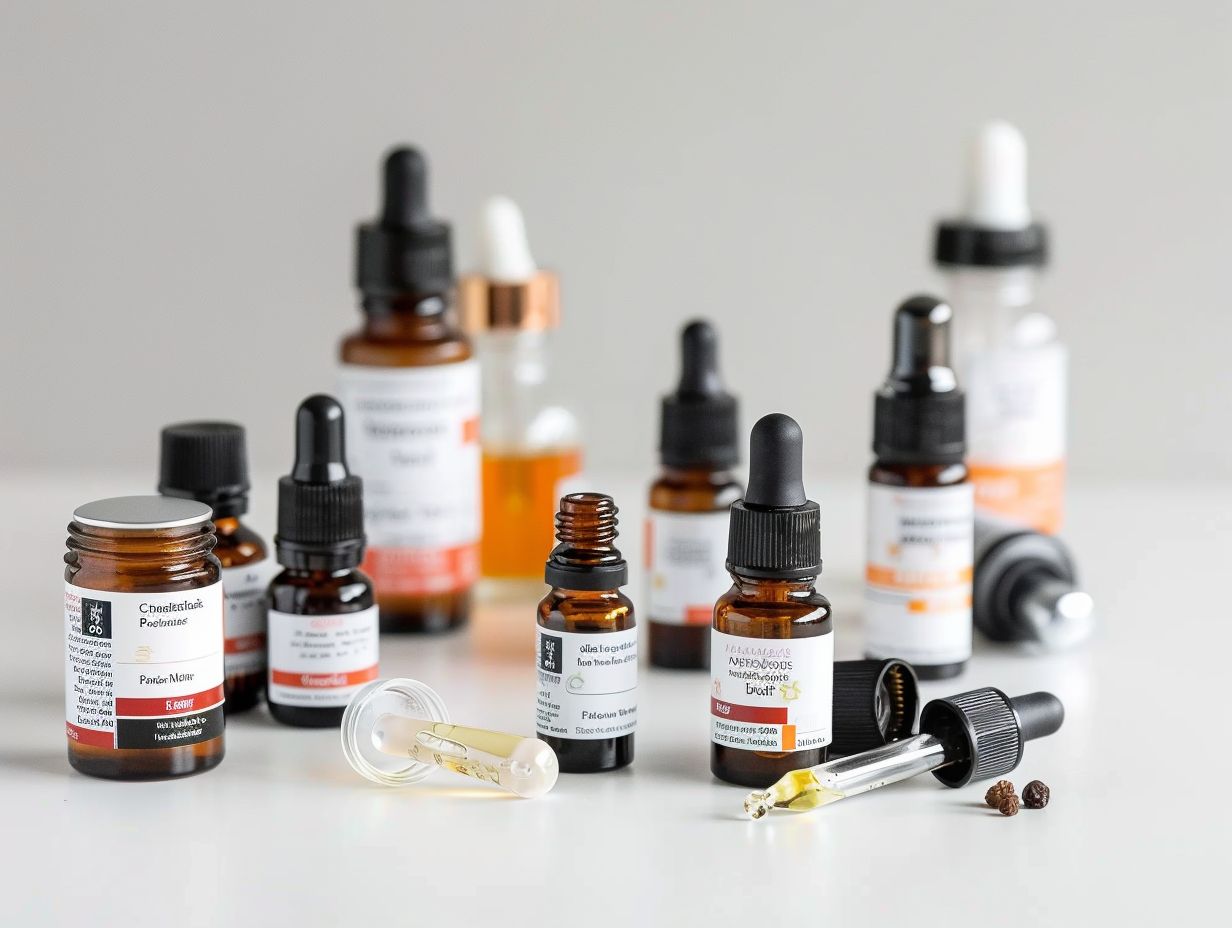
When citrus oils are applied on the skin and exposed to sunlight, they contain compounds that make the skin more sensitive to UV radiation, a phenomenon known as photosensitivity. This heightened sensitivity can result in adverse reactions, such as severe sunburns, rashes, or pigmentation changes, due to the phototoxicity of certain citrus oils.
To avoid such risks, it is advisable to use caution when utilizing citrus oils on the skin, especially prior to sun exposure.
Cinnamon and Clove
Cinnamon and Clove essential oils are potent oils that can cause skin irritation, redness, or sensitivities when used undiluted or in high concentrations, making them unsuitable for direct skin application.
When these essential oils are applied directly to the skin without proper dilution, they can lead to adverse reactions such as itching, burning, or even blistering. Clove oil contains eugenol, a compound known for its potential to cause skin irritation. On the other hand, Cinnamon oil can be harsh on the skin due to its cinnamaldehyde content.
To prevent these skin irritations, it is crucial to dilute these oils with a carrier oil before applying them to the skin. A common dilution ratio is 1-2% essential oil to carrier oil. Patch testing is also recommended before full application to check for any sensitivities or allergies.
Always follow safe usage practices when using these potent oils. Clove and Cinnamon essential oils can be safely diffused or used in products like soaps or candles where direct skin contact is avoided.
Wintergreen and Birch
Wintergreen and Birch essential oils contain high levels of methyl salicylate, which can be toxic or irritating to the skin, especially in concentrated forms, warranting caution when using them topically or in blends.
When applied undiluted or in large amounts, these oils can lead to skin sensitization, burns, and other adverse reactions. Ingesting these oils by accident or in excess amounts can also have serious consequences, such as digestive issues, respiratory problems, or even potential toxicity depending on the quantity consumed. Due to these potential risks, it is important to consider safer alternatives for topical use, such as Lavender, Tea Tree, or Chamomile oils, which are gentler on the skin and less likely to cause irritation or adverse reactions.
Frequently Asked Questions
How many essential oils can be mixed together for skin?
There is no set limit on the number of essential oils that can be mixed together for skin, but it is important to use caution and proper dilution ratios.
Can I mix any essential oils together for skin?
While essential oils can have numerous benefits for the skin, not all essential oils are suitable for mixing together. It’s important to research and understand the properties of each oil before mixing.
What are some essential oils that can be mixed together for skin?
Some commonly mixed essential oils for skin include lavender, tea tree, frankincense, and rosemary. However, the combinations are endless and you can experiment to find what works best for your skin.
What is the proper way to mix essential oils for skin?
Essential oils should always be properly diluted with a carrier oil before applying to the skin. A general rule of thumb is to use 1-2 drops of essential oil per teaspoon of carrier oil.
Is it safe to mix essential oils for skin?
When diluted properly, essential oils can be safe to mix for skin use. However, it’s important to patch test and be aware of any potential allergies or sensitivities before using on a larger area of skin.
Can I mix essential oils with other skincare products?
Yes, essential oils can be added to other skincare products such as moisturizers, serums, and masks for added benefits. However, always check the compatibility of the oils with the product before mixing.

